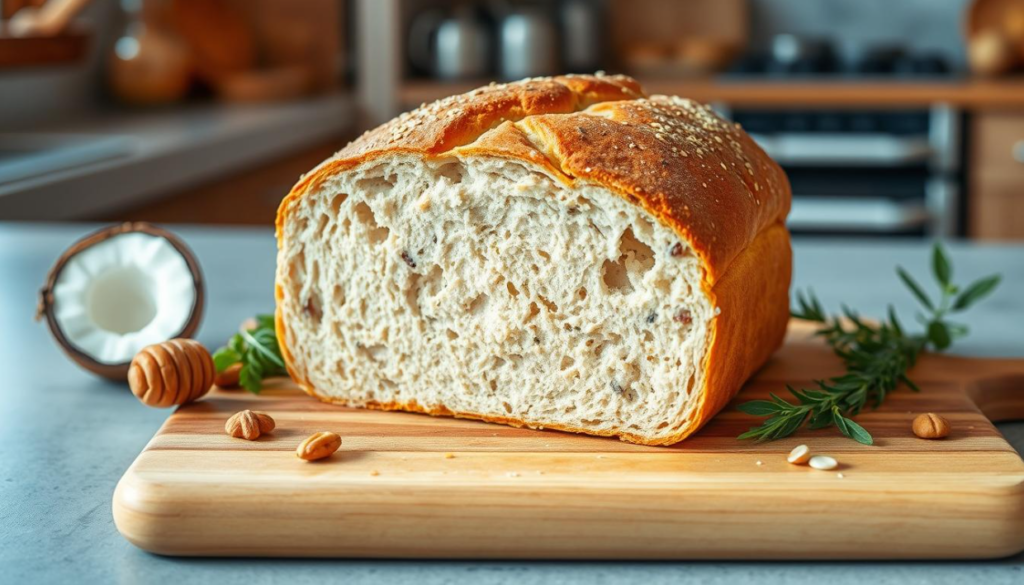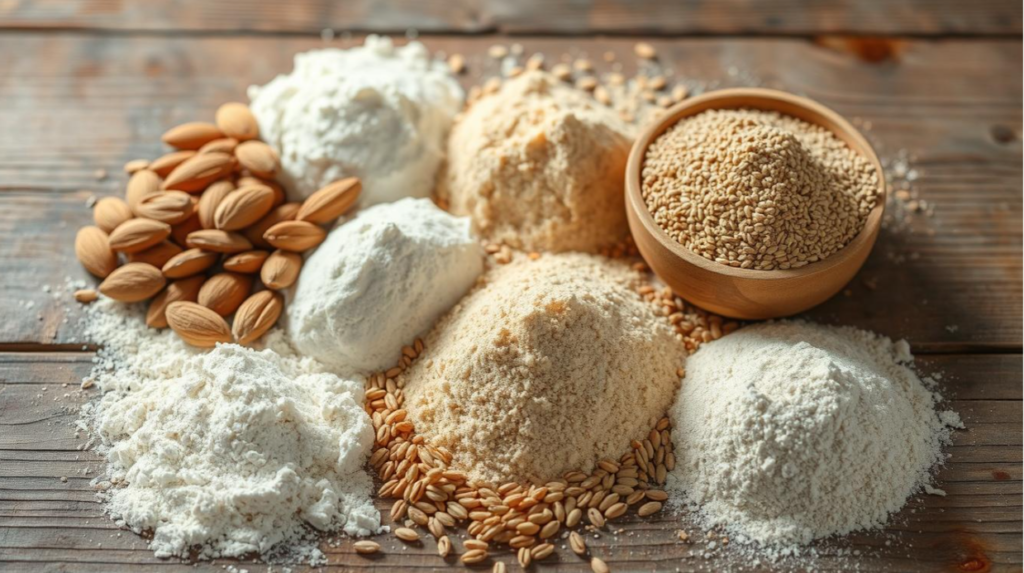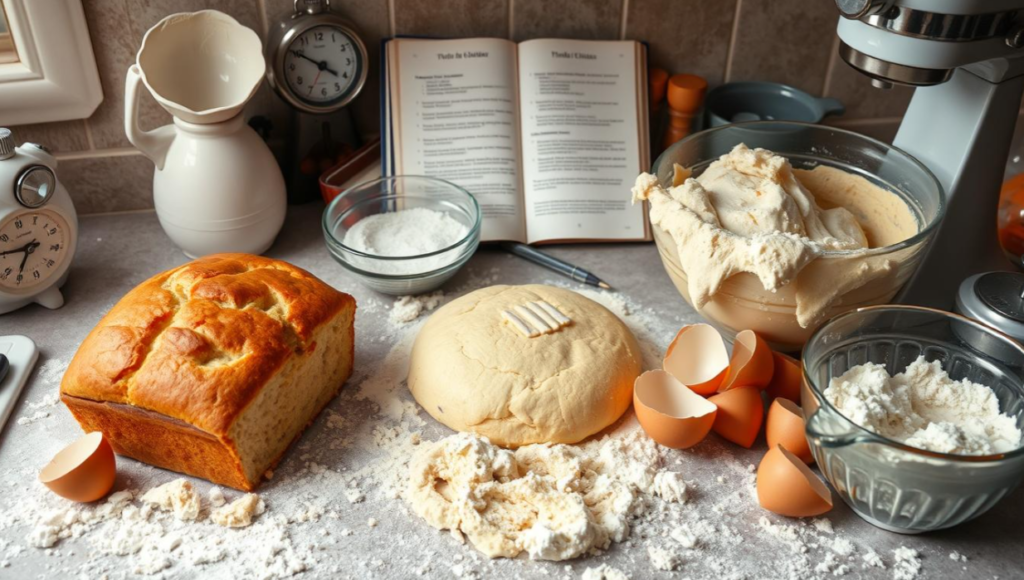Welcome to our look at an egg-free bread recipe for the Stage 4 GAPS diet. The GAPS diet, created by Dr. Natasha Campbell-McBride, boosts gut health. It helps those with digestive issues. We’ll show how a gluten-free bread can be a great addition to your meals.
This bread is easy to make and good for your health. It’s perfect for those following the Stage 4 GAPS diet. We’ll talk more about its ingredients and how to make it.

A rustic loaf of bread on a wooden cutting board, made with gluten-free flours and seeds, surrounded by fresh herbs and ingredients like coconut oil, honey, and nuts, with a soft and inviting texture, showcasing a golden-brown crust and fluffy interior, in a cozy kitchen setting with natural light streaming in.
Introduction to the GAPS Diet
The GAPS diet focuses on gut health. It aims to fix the gut lining and link gut function to overall health. It suggests that gut imbalances can cause many health issues.
The diet has several stages, each adding new foods slowly. This helps the body heal with nutrient-rich foods. People often see health improvements, thanks to the diet’s focus on nutrition.
The GAPS diet takes a holistic view of health. It emphasizes gut health to improve physical, mental, and emotional well-being.
What is Stage 4 of the GAPS Diet?
Stage 4 of the GAPS diet is a key transition phase. It allows for a wider variety of foods, including complex carbs and fruits and nuts. This variety is crucial for improving gut health and overall well-being.
Overview of Nutritional Goals
The goals in Stage 4 are to stabilize the gut and improve digestion. It focuses on adding foods rich in nutrients to boost immunity and aid in recovery. The aim is to give the body enough energy while staying true to the GAPS diet principles.
Foods to Include in Stage 4
In this stage, you can add many nourishing foods to your diet. Some of these include:
- Well-cooked vegetables
- Homemade broths
- Certain dairy products, such as yogurt and kefir
- Fresh fruits like apples and bananas
- Nuts and seeds in moderation
These foods help make your diet more diverse. They support digestive health and improve your nutritional profile, helping you recover further.
Importance of Egg-Free Recipes
Cooking without eggs can be tricky, especially for those with dietary needs. Luckily, many egg substitutes make cooking without eggs easier and fun. These substitutes help people with allergies or intolerances and open up more food options for everyone.
Common Egg Substitutes
Many ingredients can replace eggs, providing the needed binding for recipes:
- Flax Seeds: Ground flax seeds mixed with water create a gel-like substance ideal for binding.
- Chia Seeds: Similar to flax, they form a thick gel when soaked, enhancing texture in baked goods.
- Applesauce: This natural fruit puree adds moisture and sweetness, making it perfect for cakes and muffins.
- Silken Tofu: A versatile substitute that adds richness and moisture to recipes.
Benefits of an Egg-Free Diet
Choosing an egg-free diet has many benefits. People may see:
- Lower Cholesterol: Egg-free cooking can significantly reduce dietary cholesterol intake.
- Allergy Management: Removing eggs from meals helps manage allergies for sensitive individuals.
- Increased Variety: Experimenting with egg substitutes encourages creativity in meals, leading to diverse flavors and textures.
An egg-free diet promotes better health choices and boosts culinary creativity with many egg substitutes. Enjoying egg-free cooking opens up new ways to make nutritious and tasty meals.
Key Ingredients for Bread
Making GAPS-friendly bread means picking the right ingredients. Focus on alternative flours that meet diet needs and boost nutrition. Almond flour and coconut flour are great choices. They’re gluten-free and full of good stuff.
Alternative Flours for the GAPS Diet
Alternative flours are key for the GAPS diet. They make tasty bread without gluten or harmful stuff. Here are some top picks:
- Almond Flour: It’s full of protein and healthy fats, giving a sweet taste to recipes.
- Coconut Flour: It’s rich in fiber and low in carbs, but needs more liquid in recipes.
- Flaxseed Meal: It’s loaded with omega-3s, adding nutrition and helping bind ingredients in egg-free bread.
Understanding Fermentation and Its Benefits
Fermentation is vital for GAPS diet bread. It breaks down sugars, making bread easier to digest and more nutritious. Fermentation also:
- Boosts nutrient absorption by breaking down antinutrients.
- Improves flavor, making bread more tasty.
- Supports gut health by feeding good bacteria, fitting the GAPS diet’s goals.

A variety of alternative flours arranged artistically for GAPS diet bread fermentation, including almond flour, coconut flour, tapioca flour, and flaxseed meal, placed on a rustic wooden surface with a soft light illuminating the textures and colors of each flour.
| Flour Type | Nutritional Benefits | Usage Tips |
|---|---|---|
| Almond Flour | High in protein, healthy fats, and vitamins | Use in combination with other flours for best texture |
| Coconut Flour | Rich in fiber, low in carbs, promotes satiety | Use less than other flours; requires extra liquids |
| Flaxseed Meal | High in omega-3s and antioxidants | Mix with water to create an egg substitute |
Stage 4 Gaps Diet Bread Recipe Without Eggs
Making a tasty GAPS diet bread without eggs is rewarding. This recipe uses key Egg-free bread recipe ingredients. It’s easy to follow, even if you’re new to baking. This step-by-step bread recipe makes sure you can bake great bread while following GAPS rules.
Ingredients List
- 1 cup almond flour
- 1/2 cup coconut flour
- 1/4 cup ground chia seeds
- 1/2 teaspoon baking soda
- 1/4 teaspoon salt
- 1 cup water
- 2 tablespoons olive oil
- 2 tablespoons apple cider vinegar
Step-by-Step Instructions
- Preheat the oven to 350°F (175°C).
- In a large mixing bowl, combine almond flour, coconut flour, ground chia seeds, baking soda, and salt.
- In a separate bowl, whisk together water, olive oil, and apple cider vinegar.
- Slowly pour the wet mixture into the dry ingredients while stirring continuously.
- Mix until a thick batter forms. Let it sit for 5 minutes to allow the chia seeds to absorb moisture.
- Transfer the dough to a greased loaf pan, smoothing the top with a spatula.
- Bake for 40-45 minutes or until the top is golden and a toothpick comes out clean.
- Allow the bread to cool in the pan for 10 minutes before transferring it to a wire rack.
Tips for Perfect Egg-Free Bread
Baking egg-free bread needs the right ingredients and techniques for a perfect loaf. Follow these tips to make the baking process easier. Keep an eye on baking times and use proper storage to keep your bread fresh.
Choosing the Right Baking Time
The baking time for egg-free bread depends on your oven and recipe. Check for doneness by inserting a toothpick into the bread’s center. If it’s clean, your bread is done. Several factors can change your baking time:
- Oven Temperature: Make sure your oven is at the right temperature before baking.
- Pan Size: The size and material of your pan affect cooking time.
- Recipe Variations: Different ingredients can change how long it takes to bake.
How to Store Your Bread
After baking, storing your egg-free bread properly is key to keeping it fresh. Here are some tips for storing bread:
- Airtight Containers: Use airtight containers or wrap your bread tightly in plastic wrap to prevent drying.
- Freezing: Freeze slices or whole loaves if you won’t eat them in a few days.
- Cool Completely: Let the bread cool completely before storing to avoid mold.
Enhancing Flavor and Texture
Flavor and texture are key to making bread better, especially on the GAPS diet. By using herbs, spices, seeds, and nuts, you can make every bite special. We’ll show you how to add GAPS diet seasonings and make your bread unique.
Incorporating Herbs and Spices
Herbs and spices can change your bread’s taste. Here are some great options:
- Rosemary: It has a strong flavor, perfect for savory breads.
- Thyme: It adds a mild earthy taste, great for aromatic loaves.
- Oregano: It brings a Mediterranean taste, good with many ingredients.
- Garlic Powder: It’s perfect for those who like a bit of garlic.
Trying out these herbs and spices not only makes your bread taste better. It also lets you be creative in the kitchen.
Adding Seeds and Nuts
Adding seeds and nuts makes your bread crunchy and healthier. Here are some good choices:
- Chia seeds: They’re full of omega-3s and fiber, great for health lovers.
- Sunflower seeds: They have a sweet taste and add texture.
- Walnuts: They add a rich flavor and healthy fats.
- Pumpkin seeds: They taste nutty and are full of antioxidants.
This mix of seeds and nuts makes your bread better in taste and nutrition. It makes baking more rewarding.
| Ingredient | Flavor Profile | Nutritional Benefit |
|---|---|---|
| Rosemary | Robust | Rich in antioxidants |
| Thyme | Earthy | Anti-inflammatory properties |
| Chia Seeds | Neutral | High in fiber and omega-3 |
| Walnuts | Rich | Contains healthy fats |
Customizing your GAPS diet bread with these flavor enhancements makes meals more enjoyable. Find your favorites and use them in your recipes for a special touch!
Common Mistakes to Avoid
Baking bread without eggs can be tricky. Knowing common mistakes helps a lot. Pay attention to dough mixing tips and bread measuring accuracy. These are key for a great bake.
Overmixing the Dough
Overmixing the dough makes bread dense and heavy. Too much gluten ruins the texture and rise. Mix just enough to combine ingredients without overworking the dough.
This keeps the bread light. Gentle kneading is essential. Good dough mixing tips help keep the right texture.
Using Incorrect Measuring Techniques
Getting bread measuring right is vital. Volume measurements can mess up dough consistency. Use a digital scale for accurate flour and liquid measurements.
Wrong ratios make dough too wet or dry. This affects the final bread. Always double-check your measurements to avoid mistakes.

A cluttered kitchen countertop filled with various baking mistakes: a loaf of bread with an overcooked crust, a sticky dough that didn’t rise, spilled flour everywhere, broken eggshells, and an overflowing mixing bowl. Include a measuring cup tipped over, a confused timer, and ingredients poorly organized. The background features a recipe book opened to a page with crossed-out errors.
Variations on the Basic Recipe
There’s more to bread than just the basic recipe. You can try different flavors and add nutrients that fit your taste. Adding vegetables makes your bread not only tasty but also packed with vitamins and minerals.
Adding Vegetables for Extra Nutrition
Adding grated zucchini, carrots, or steamed spinach to your dough boosts your bread’s nutrition. These veggies make your bread moist and add important nutrients. It’s a great way to enjoy healthy vegetable bread while following the GAPS diet.
Sweet Alternatives for Breakfast Breads
For a sweet breakfast treat, mix in mashed bananas or applesauce. These natural sweeteners add flavor and fit the GAPS diet. You can also add spices like cinnamon or nutmeg for extra taste. This way, you get a delicious, healthy bread to start your day.
FAQ
What is the GAPS diet?
The GAPS diet, or Gut and Psychology Syndrome diet, was created by Dr. Natasha Campbell-McBride. It aims to heal the gut lining and boost overall health. It focuses on foods rich in nutrients and gradually adds different foods to improve gut health and brain function.
What are the main goals of the Stage 4 GAPS diet?
Stage 4 of the GAPS diet introduces more complex carbs and diversifies food types. It allows certain fruits and nuts. The goal is to maintain good digestion and support a healthy gut microbiome.
Can I make bread on the GAPS diet without eggs?
Yes! You can make delicious egg-free bread for the GAPS diet. Use flax seeds or chia seeds as binders. This way, those with egg allergies can enjoy tasty bread that’s good for their gut.
What are some common egg substitutes for baking?
Flax seeds, chia seeds, applesauce, and mashed bananas are great egg substitutes. They add moisture and help bind ingredients, making them ideal for egg-free bread.
What should I consider when choosing flours for the GAPS diet?
Choose gluten-free flours like almond flour, coconut flour, or sunflower seed flour for the GAPS diet. These flours are nutritious and improve the texture of baked goods.
How can I enhance the flavor and texture of my GAPS diet bread?
Add fresh herbs like rosemary and thyme for flavor. Seeds and nuts add crunch and nutrition. Experimenting with these can make your bread taste better.
What are some tips for perfecting my egg-free bread?
Focus on baking time and temperature. Use an oven thermometer for accuracy. Store your bread in airtight containers to keep it fresh.
What are common mistakes to avoid when making bread on the GAPS diet?
Avoid overmixing the dough to prevent a dense texture. Accurate measuring is key for successful baking. Use precise measuring techniques.
How can I make variations of the basic GAPS diet bread recipe?
Add vegetables like zucchini for moisture and nutrition. For sweet variations, use natural sweeteners. These changes are perfect for breakfast or snacks on the GAPS diet.